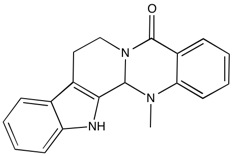Evodiamine | TRPV1 activator/anti-inflammatory/antiangiogenic

Available Options
| Size : | Price | Quantity | |
|---|---|---|---|
| 10 mg | $30.00 | ||
| 50 mg | $90.00 |
Evodiamine (518-17-2) is a quinolone alkaloid isolated from Evodia rutaecarpa.1 Evodia Rutaecarpa is a very popular herb used in traditional chinese medicine to treat a variety of ailments. Evodiamine has been shown to elicit a variety of biological effects including induction of apoptosis, inhibiting cancer cell proliferation, promoting cell cycle arrest in G2/M, inhibiting invasion and metastasis of cancer cells, inhibiting angiogenesis, induction of oxidative stress and subsequent apoptosis and inhibition of NF-κB.2 It also functions as an activator of TRPV1 (EC50 = 1.03 μM)3 and acts as an anti-inflammatory agent4.
References/Citations:
1) Shoji et al. (1986) Isolation of evodiamine, a powerful cardiotonic principle, from Evodia Rutaecarpa Bentham (Rutaceae); J. Pharm. Sci. 75 612
2) Jiang and Hu et al. (2009) Evodiamine: A novel anti-cancer alkaloid from Evodia rutaecarpa; Molecules, 14 1852
3) Pearce et al. (2004) Evodiamine functions as an agonist for the vanilloid receptor; Org. Biomol. Chem., 2 2281
4) Choi et al. (2006) Anti-inflammatory principles from the fruits of Evodia rutaecarpa and their cellular action mechanisms; Arch. Pharm. Res., 29 293
Safety Data Sheet:
Product Data Sheet:
Materials provided by Focus Biomolecules are for laboratory research use only and are not intended for human or veterinary applications. Please note that we do not sell to individuals and that all orders placed by non-research organizations will incur a $20 restocking/refund fee
Evodiamine (518-17-2) is a quinolone alkaloid isolated from Evodia rutaecarpa.1 Evodia Rutaecarpa is a very popular herb used in traditional chinese medicine to treat a variety of ailments. Evodiamine has been shown to elicit a variety of biological effects including induction of apoptosis, inhibiting cancer cell proliferation, promoting cell cycle arrest in G2/M, inhibiting invasion and metastasis of cancer cells, inhibiting angiogenesis, induction of oxidative stress and subsequent apoptosis and inhibition of NF-κB.2 It also functions as an activator of TRPV1 (EC50 = 1.03 μM)3 and acts as an anti-inflammatory agent4.
References/Citations:
1) Shoji et al. (1986) Isolation of evodiamine, a powerful cardiotonic principle, from Evodia Rutaecarpa Bentham (Rutaceae); J. Pharm. Sci. 75 612
2) Jiang and Hu et al. (2009) Evodiamine: A novel anti-cancer alkaloid from Evodia rutaecarpa; Molecules, 14 1852
3) Pearce et al. (2004) Evodiamine functions as an agonist for the vanilloid receptor; Org. Biomol. Chem., 2 2281
4) Choi et al. (2006) Anti-inflammatory principles from the fruits of Evodia rutaecarpa and their cellular action mechanisms; Arch. Pharm. Res., 29 293
Related TRP Channel Effectors
Download
Calculate the molar concentration, mass or volume in a solution.
Concentration × Volume × Molecular Weight = Mass
Focus Biomolecules • Plymouth Meeting, PA USA • 1-855-FOCUS21
Focus Biomolecules
Plymouth Meeting, PA USA
1-855-FOCUS21
Website Created by Advanta Advertising LLC.

